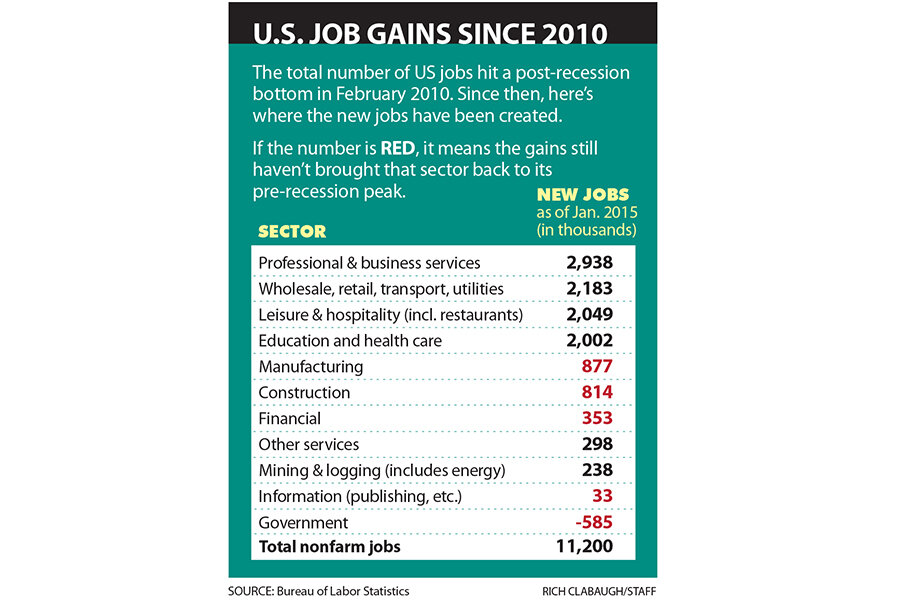Bipartisan ways to create more jobs
Loading...
| Washington
A few months ago, a Washington panel discussion on the job market featured a liberal labor economist (the audience could see Jared Bernstein seated, perhaps coincidentally, on the left end of the table) and a conservative one (Michael Strain, seated appropriately enough on the right).
What was interesting was this: They seemed to agree more often than disagree. They and other panelists concurred that, even after years of post-recession improvement, policies are still needed to draw people back into the labor market and to help them be productive.
As the panelists offered specific ideas – from infrastructure investments to “work sharing” as an alternative to layoffs – the discussion included more words of approval than of debate.
The point isn’t that Mr. Bernstein, a senior fellow at the Center on Budget and Policy Priorities, and Mr. Strain, a scholar at the American Enterprise Institute, agree on every policy – much less that a roomful of economists would, either. But their alignment on some big points hints at least at a potential for labor-policy action, even in a politically divided nation. Admittedly, a key challenge is that both political parties often seem more interested in pleasing their base supporters than in seeking common ground and creative problem-solving.
What are the policy options? From economists on that panel and beyond, here are some themes and suggested ways to boost job creation:
Get the whole economy running smoother.
Jobs grow out of a strong economy. Steps here could include tax reform that attracts more corporate investment to America. Wise infrastructure investments could lay the foundation for more job growth. Education investments would boost America’s “human capital,” a key to nurturing better-paying jobs.
Perhaps most important is to “first do no harm,” through regulatory and fiscal efforts to guard against a repeat of 2008’s devastating financial crisis. An Obama administration proposal to levy a new tax on big banks based on their leverage (or risk) is controversial, but some economists see it as a creative step in the right direction.
Keep up with technological change.
Technology is a fount of high-end jobs but also of anxiety for workers whose jobs can be jeopardized by the upheaval it brings. A range of think tank ideas could help America retain leadership in advanced industries and remain strong in manufacturing. One is that immigration reform could bring more of the high-skilled immigrants who often become entrepreneurs and innovators.
At the same time, a big priority is to bring better job-market information to US students and workers, so they can train in the skills that are most in demand, and not be blindsided by change.
Help more people connect with jobs.
Creating express bus lines from low-income neighborhoods to commercial centers could “cut that commute time from two hours down to one, so more people can be working,” Strain said at the panel discussion, which was sponsored by the Peterson Institute for International Economics.
The long-term unemployed could benefit from incentives for employers to hire them. (The group Platform to Employment, for example, is able to pay wages for two months so employers can try workers out, with no obligation to hire. About 90 percent of the workers get hired by the time the eight-week trial ends.)
Work-sharing programs, already being tried in many states, aim to avert job losses in the first place by promoting downsized hours rather than layoffs. (People who face reduced paychecks as a result would qualify for government assistance to fill the gap.)
While getting legislation passed isn’t easy these days in Washington, some of these ideas could come up in the dawning presidential campaign for 2016, under the framework of helping to revive the upward mobility of the middle class. That’s a theme of President Obama’s recent budget proposals, but also of Republican contenders to succeed him, including former Florida Gov. Jeb Bush. It’s also worth noting that some job-market improvements can be pursued at the state and local level.
Many Americans aren’t asking for much. Lidia Sotomayor, who recently went through a Connecticut training program that helps the long-term unemployed find work, says the jobless residents she’s met aren’t lazy, unskilled, or being unrealistic in their job-search hopes. They just “honestly and truly want to go to work.”





